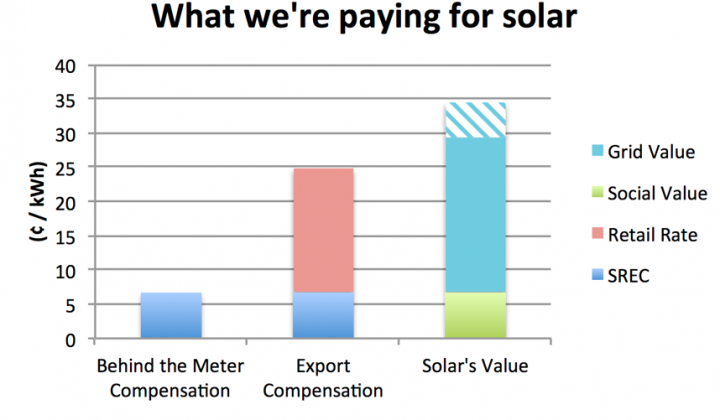How much are we paying for solar?

It’s important to realize that compensation for solar varies widely across utility territories, project types and over time as electricity rates and SREC prices change. That makes it difficult to assign an exact price for all solar electricity at any one point in time.
The utilities are fond of asserting that we’re paying 45-60 cents/kWh. However, assumes a solar project is exporting all of its electricity to the grid, receiving SREC I prices and net metering compensation equal to the unprecedented electricity rates (i.e. 24 cents/kWh) of winter 2014. Here’s why that’s wrong.
(1) Not all projects export electricity to the grid. Most of the 1000 MW of solar projects in Massachusetts are rooftop solar systems that consume most, if not all, of their electricity on-site. Solar electricity consumed behind-the-meter, doesn’t cost ratepayers anything from a net metering perspective. Instead, it reduces a particular  property’s demand for electricity from the grid, and in this way functions a great deal like energy efficiency from a grid/utility perspective. Solar electricity that is consumed on-site (i.e., that is not net metered) thus only “costs” ratepayers from a solar incentive (i.e., SREC) perspective, the price of which is discussed in further detail below. Solar electricity that is exported to the grid is compensated through net metering at the same rate that electricity account pays for electricity. At the moment, it’s fair to say that the cost of this compensation is around 18 cents/kWh.
property’s demand for electricity from the grid, and in this way functions a great deal like energy efficiency from a grid/utility perspective. Solar electricity that is consumed on-site (i.e., that is not net metered) thus only “costs” ratepayers from a solar incentive (i.e., SREC) perspective, the price of which is discussed in further detail below. Solar electricity that is exported to the grid is compensated through net metering at the same rate that electricity account pays for electricity. At the moment, it’s fair to say that the cost of this compensation is around 18 cents/kWh.
In summary, the net metering cost of solar for electricity consumed on-site is 0. The cost for solar electricity exported to the grid is about 18 cents/kWh.
(2) Not all solar projects receive the same solar incentive. The first round of solar projects developed in Massachusetts (about 600 MW in total) receive SREC I credits. These credits are currently worth about $450/MWh (45 cents/kWh) and are issued for the first 10 years a solar system is operating. The high price of SREC I credits was intentional because the first SREC program was designed to jumpstart the solar market in Massachusetts at a time when solar panel prices were high and a relatively limited number of solar companies existed in Massachusetts.
SREC I was very successful in building a healthy and robust solar market in Massachusetts. Its successor program, SREC II, provides new solar projects with a much lower solar incentive. Current SREC prices for new solar projects range from $220-$270/MWh depending on the type of project. Low income, community shared and residential rooftop solar get the highest incentive, to encourage developers to focus on these market segments and encourage homeowners to go solar. All other types of projects receive lower incentives.
But you can’t just look at the current value of an SREC when determining how much we’re paying for solar electricity. That’s because SRECs are earned over the first 10 years a project is operating but solar systems will generate electricity for 25-30 years. In many ways, the SREC is an upfront payment for a long-lived source of electricity. If you average the cost of an SREC at today’s prices over the life of a solar project, solar projects receive an incentive on the order of 6-7 cents/kWh. Furthermore, when you average out the cost of SRECs in this manner and then compare Massachusetts’ solar incentive with solar incentives in other states (which are often paid out over 20 years or more), our incentives are in line with those states that have healthy solar markets but higher than states that don’t have healthy solar markets, such as Connecticut and Rhode Island.
It’s also important to note that SREC II is designed to realize the installation of 1600 MW of solar (increasing the installed capacity of solar from the 600 MW that SREC I realized). It’s expected that SREC II will reach its limit this year. After that, it’s up to the legislature to design a follow on incentive program and everyone fully expects incentive levels to decline even further. At this point, that is warranted as solar panels prices have reduced further and the solar market continues to innovate to drive down costs.
In summary, the SREC price for new solar projects in Massachusetts averaged over the life of a solar system is 6-7 cents/kWh.
Taking into account net metering compensation and SREC incentives, solar projects are paid anywhere from 7 cents/kWh (for electricity consumed on-site) to 25 cents/kWh (for electricity exported to the grid.
Finally, don’t forget solar’s benefits. If you look at what solar is paid compared to its value, ratepayers are getting a pretty good deal. The chat below compares the kWh compensation for solar electricity for new solar projects, both on-site and exported electricity, with the Acadia Center’s value of solar study. That study estimated that value of solar to be 29-34 cents/kWh, which includes the societal and environmental benefits of solar. When you consider that ratepayers are paying 7-25 cents/kWh for a commodity that is worth more, it’s fair to say that at least from a value perspective, we’re not paying too much for solar electricity. Finally, the Net Metering and Solar Task Force confirmed that the benefits of solar exceed the costs. Their report shows that the Commonwealth at-large receives a total of $10.2 billion in net benefits from solar compared to net costs of $4.5 billion (Source: NMSTF report, pg 195).


